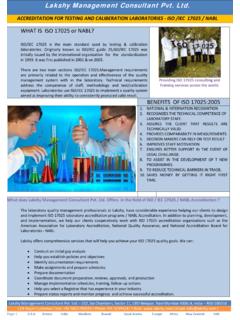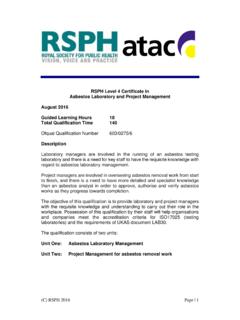Transcription of Content Sheet 10-1: Overview of External Quality ...
1 External Quality assessment Module 10 Content Sheet 1 Content Sheet 10-1: Overview of External Quality assessment (EQA) Role in Quality management system assessment is a critical aspect of laboratory Quality management, and it can be conducted in several ways. One of the commonly employed assessment methods is that of External Quality assessment . Definition of EQA The term External Quality assessment (EQA) is used to describe a method that allows for comparison of a laboratory s testing to a source outside the laboratory. This comparison can be made to the performance of a peer group of laboratories or to the performance of a reference laboratory. The term EQA is sometimes used interchangeably with proficiency testing ; however, EQA can also be carried out using other processes. EQA is here defined as a system for objectively checking the laboratory s performance using an External agency or facility. Types of EQA Several EQA methods or processes are commonly used.
2 These include: 1. proficiency testing External provider sends unknown samples for testing to a set of laboratories, and the results of all laboratories are analyzed, compared, and reported to the laboratories. 2. Rechecking or retesting slides that have been read are rechecked by a reference laboratory; samples that have been analyzed are retested, allowing for inter-laboratory comparison. Organization Personnel Equipment Purchasing & Inventory Process Control Information Management Documents & Records Occurrence Management assessment Process Improvement Customer Service Facilities & Safety External Quality assessment Module 10 Content Sheet 2 3. On-site evaluation usually done when it is difficult to conduct traditional proficiency testing or to use the rechecking/retesting method. Another method of inter-laboratory comparison is the exchange of samples among a set of laboratories, usually reserved for specialized tests for which no proficiency testing is available.
3 This method is used either by very specialized or sophisticated laboratories and therefore will not be further discussed in this module. EQA benefits Participation in an External Quality assessment program provides valuable data and information which: allows comparison of performance and results among different test sites; provides early warning for systematic problems associated with kits or operations; provides objective evidence of testing Quality ; indicates areas that need improvement; identifies training needs. EQA helps to assure customers, such as physicians, patients, and health authorities, that the laboratory can produce reliable results. Individual laboratories can use EQA to identify problems in laboratory practices, allowing for appropriate corrective action. EQA participation will help to evaluate reliability of methods, materials, and equipment, and to evaluate and monitor training impact. For laboratories performing public health-related testing , EQA can help to assure that results from different laboratories during surveillance activities are comparable.
4 EQA participation is usually required for accreditation. Also, EQA participation creates a network for communication, and can be a good tool for enhancing a national laboratory network. Samples received for EQA testing , as well as the information shared by the EQA provider, are useful for conducting continuing education activities. Principal characteristics of an EQA scheme EQA programs vary but principal characteristics include the following: EQA programs can either be free-of-charge or require a fee. Free EQA programs include those offered by a manufacturer to ensure equipment is working correctly and those organized by a regional or national program for Quality improvement. External Quality assessment Module 10 Content Sheet 3 Some EQA programs are obligatory, either required by an accrediting body or by law. Others are voluntary, and the Quality manager may choose to voluntarily participate in an EQA program in order to achieve improvement in the Quality of the laboratory s performance.
5 The EQA program can be organized at different levels: regional, national, or international. Individual laboratory results are kept confidential, and generally are only known by the participating laboratory and the EQA provider. A summary is generally provided and allows comparison to the overall group. Some EQA schemes may address a single disease, for example the EQA program for tuberculosis. Others may address many kinds of laboratory tests, looking at the overall testing performance for microbiology. An example of this multi-disease or test program is the national microbiology EQA in France, which is obligatory. Successful performance in an EQA program reflects the effectiveness of the laboratory s Quality management, and allows for recognition of laboratory Quality by External groups. EQA is important for improvement of the laboratory Quality management system, as it is a measure of laboratory performance. External Quality assessment Module 10 Content Sheet 4 Content Sheet 10-2: proficiency testing Definitions proficiency testing , or PT, has been in use by laboratories for many years.
6 It is the most commonly employed type of EQA, as it is able to address many laboratory methods. proficiency testing is available for most of the commonly performed laboratory tests, and covers a range of chemistry, haematology, microbiology, and immunology testing . Most laboratorians are familiar with the proficiency testing process, and many laboratories employ some kind of proficiency testing . Standards organizations recognize the importance of this tool, and the following are examples of formal definitions that are in use. ISO/IEC Guide 43-1:1997: proficiency testing schemes (PTS) are interlaboratory comparisons that are organized regularly to assess the performance of analytical laboratories and the competence of the analytical personnel . CLSI: A program in which multiple samples are periodically sent to members of a group of laboratories for analysis and/or identification; whereby each laboratory s results are compared with those of other laboratories in the group and/or with an assigned value, and reported to the participating laboratories and others.
7 proficiency testing process In the proficiency testing process, laboratories receive samples from a proficiency testing provider. This provider may be an organization (non-profit or for-profit) formed specifically to provide PT. Other providers of proficiency testing include central reference laboratories, government health agencies, and manufacturers of kits or instruments. In a typical PT program, challenge samples are provided at regular intervals. An optimal frequency will be 3 4 times yearly. If the program cannot provide challenges with this frequency, the laboratory may be able to seek additional sources. The laboratories participating in the program analyze the samples and return their results to the central organization. Results are evaluated and analyzed, and the laboratories are provided with information about their performance and how they compared with other participants. The participating laboratories use the information regarding their performance to make appropriate changes and improvements.
8 Roles of laboratory To be successful, PT instructions must be followed carefully, all paper work completed accurately, and results submission deadlines met. All PT results, as well as corrective actions, should be recorded and the records maintained for an appropriate period of time. PT is a tool to measure laboratory performance. Therefore, there must be no difference in the treatment of PT samples and the patient s sample. proficiency External Quality assessment Module 10 Content Sheet 5 testing providers make every effort to produce samples that exactly mimic, or closely resemble, usual samples received from patients. PT samples must be processed by normal testing method(s) and involve personnel who routinely perform the testing . When PT is used for any purpose other than internal Quality improvement, the provider or central organization generally prohibits the discussion of results with other laboratories. Some PT organizers send different samples to different groups of laboratories to avoid inter-laboratory discussion.
9 Nothing is gained from PT participation unless the information received is directed to improvement in the laboratory. Limitations It is important to remember that PT does have some limitations and it is not appropriate to use PT as the only means for evaluating the Quality of a laboratory. PT results are affected by variables not related to patient samples, including preparation of the sample, matrix effects, clerical functions, selection of statistical methods of evaluation, and peer group definition. PT will not detect all problems in the laboratory, particularly those that address the pre- and post-examination procedures. A single unacceptable result does not necessarily indicate that a problem exists in the laboratory. External Quality assessment Module 10 Content Sheet 6 Content Sheet 10-3: Other EQA Methods Using other EQA methods In situations where it is difficult to provide appropriate External samples, or sometimes, when normal laboratory Quality control methods cannot be applied, other procedures have been developed and used for EQA.
10 The primary examples, and their uses, are as follows. Rechecking/retesting has been used traditionally for EQA for microscopic slides for acid-fast bacilli (AFB), and for human immunodeficiency virus (HIV) rapid testing . It can also be used in other situations, but is not usually employed if traditional PT is feasible. On-site evaluation has proven a useful technique for the same situations AFB examination and HIV rapid testing . It allows for an External evaluation of Quality on-site, and can be conducted in conjunction with proficiency testing or rechecking/retesting. These procedures can be time-consuming and costly, and so are used only when there are not good alternatives. It is essential to have a reference laboratory with the capacity to do the repeat testing ; the use of a reference laboratory gives assurance that the re-examination process will give a dependable result. The turnaround for the retesting must be accomplished in a timely manner allowing for immediate corrective actions.
















